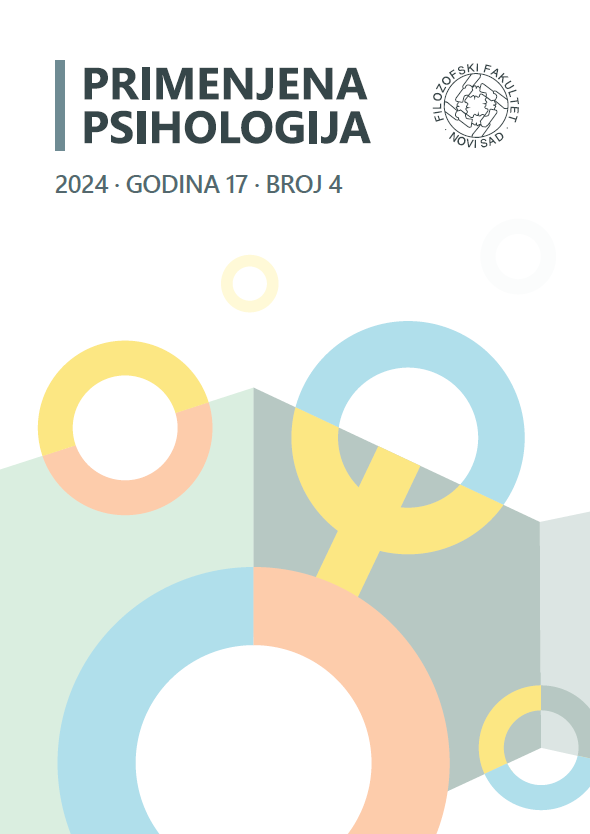Interpersonalne kognitivne distorzije kao medijator učinka socijalne anksioznosti i depresivnosti na usamljenost studenata
DOI:
https://doi.org/10.19090/pp.v17i4.2527Ključne reči:
usamljenost, socijalna anksioznost, depresivni simptomi, kognitivne distorzije, studentiApstrakt
Istraživanje je provedeno s ciljem utvrđivanja jesu li interpersonalne kognitivne distorzije u podlozi odnosa socijalne anksioznosti i depresivnih simptoma s usamljenošću u studentskoj populaciji. Prikupljeni su podaci 228 studenata s različitih studija na području Republike Hrvatske, među kojima prednjače studijski programi društvenog usmjerenja (72.8%) te studenti preddiplomskog studija (74.1%). Istraživanje je provedeno online, a sudionici su ispunjavali Skalu depresivnosti, anksioznosti i stresa, Skalu usamljenosti, Skalu interpersonalnih kognitivnih distorzija i Skalu interakcijske anksioznosti. Kroz dvije medijacijske regresijske analize usamljenost se zasebno predviđa temeljem socijalne anksioznosti i temeljem depresivnih simptoma uz provjeru medijacijskog učinka interpersonalnih kognitivnih distorzija. Dodano su provedene još dvije medijacijske regresijske analize radi kontrole učinaka depresivnih simptoma u modelu u kojem je socijalna anksioznost prediktor te kontrole učinaka socijalne anksioznosti u modelu u kojem su prediktor depresivni simptomi. Socijalna anksioznost uz interpersonalne kognitivne distorzije objašnjava 26.8% varijance usamljenosti, a depresivni simptomi uz interpersonalne kognitivne distorzije objašnjavaju 29.7% varijance usamljenosti. Utvrđena je djelomična medijacija, odnosno socijalna anksioznost i depresivni simptomi predviđaju usamljenost izravno, i neizravno putem interpersonalnih kognitivnih distorzija. Rezultati su raspravljeni u kontekstu postojeće literature, uz prijedloge praktičnih implikacija u savjetodavnom radu.
Reference
Allen, N. B., & Badcock, P. B. (2003). The social risk hypothesis of depressed mood: evolutionary, psychosocial, and neurobiological perspectives. Psychological Bulletin, 129 (6), 887. https://doi.org/10.1037/0033-2909.129.6.887 DOI: https://doi.org/10.1037/0033-2909.129.6.887
American Psychiatric Association. (2022). Diagnostic and statistical manual of mental disorders (5th ed., text rev.). https://doi.org/10.1176/appi.books.9780890425787 DOI: https://doi.org/10.1176/appi.books.9780890425787
Auerbach, R.P., Mortier, P., Bruffaerts, R., Alonso, J., Benjet, C., Cuijpers, P., Demyttenaere, K., Ebert, D.D., Green, J.G., Hasking, P., Murray, E., Nock, M.K., Pinder-Amaker, S., Sampson, N. A., Stein, D.J., Vilagut, G., Zaslavsky, A.M. & Kessler, R.C. (2018). WHO WMH-ICS Collaborators. WHO World Mental Health Surveys International College Student Project: Prevalence and distribution of mental disorders. The Journal of Abnormal Psychology, 127(7), 623-638. https://doi.org/10.1037/abn0000362 DOI: https://doi.org/10.1037/abn0000362
Batmaz, S., Kocbiyik, S. & Yuncu, O. A. (2015). Turkish version of the cognitive distortions questionnaire: psychometric properties. Depression Research & Treatment, 2015, 1-8. https://doi.org/10.1155/2015/694853 DOI: https://doi.org/10.1155/2015/694853
Beck, A. T. (1976). Cognitive Therapy and the Emotional Disorders. International Universities Press, Oxford.
Bertha, E. A. & Balázs, J. (2013). Subthreshold depression in adolescence: A systematic review. European Child & Adolescent Psychiatry, 22, 589–603. https://doi.org/10.1007/s00787-013-0411-0 DOI: https://doi.org/10.1007/s00787-013-0411-0
Burns, D. D. (1999). The Feeling Good Handbook, Revised Edition. Penguin Books.
Burušić, J. (2009). Samopredstavljanje: Taktike i stilovi. Naklada Slap.
Chrismore, S., Betzelberger, E., Bier, L. & Camacho, T. (2011). Twelve-step recovery in inpatient treatment for Internet addiction. In K. S. Young i C. N. de Abreu (Eds.), Internet addiction: A handbook and guide to evaluation and treatment (pp. 205–222). DOI: https://doi.org/10.1002/9781118013991.ch12
Clark, D. M., & Wells, A. (1995). A cognitive model of social phobia. In R. G. Heimberg, M. R. Liebowitz, D. A. Hope, & F. R. Schneier (Eds.), Social phobia: Diagnosis, assessment, and treatment (pp. 69–93). The Guilford Press.
Danneel, S., Nelemans, S., Spithoven, A., Bastin, M., Bijttebier, P., Colpin, H., Van Den Noortgate, W., Van Leeuwen, K., Verschueren, K. & Goossens, L. (2019). Internalizing Problems in Adolescence: Linking Loneliness, Social Anxiety Symptoms, and Depressive Symptoms Over Time. Journal of Abnormal Child Psychology, 47(10), 1691-1705. https://doi.org/10.1007/s10802-019-00539-0 DOI: https://doi.org/10.1007/s10802-019-00539-0
De Jong Gierveld, J. & Van Tilburg, T. G. (2006). A 6-Item Scale for Overall, Emotional, and Social Loneliness: Confirmatory Tests on Survey Data. Research on Aging, 28(5), 582–598. https://doi.org/10.1177/0164027506289723 DOI: https://doi.org/10.1177/0164027506289723
De Jong-Gierveld, J. & Van Tilburg, T. G. (1999). Manual of the Loneliness Scale. Methoden en technieken. https://doi.org/10.17605/osf.io/u6gck
Demir, Y. & Kutlu, M. (2016). The Relationship between Loneliness and Depression: Mediation Role of Internet Addiction. Educational Process: International Journal, 5(2), 97- 105. http://dx.doi.org/10.12973/edupij.2016.52.1 DOI: https://doi.org/10.12973/edupij.2016.52.1
Fung, K., Paterson, D. & Alden, L. E. (2017). Are social anxiety and loneliness best conceptualized as a unitary trait? Journal of Social and Clinical Psychology, 36(4), 335–345. https://doi.org/10.1521/jscp.2017.36.4.335 DOI: https://doi.org/10.1521/jscp.2017.36.4.335
Hamamci, Z. & Büyüköztürk, Ş. (2004). The interpersonal cognitive distortions scale: development and psychometric characteristics. Psychological Reports, 95(1), 291-303. https://doi.org/10.2466/pr0.95.1.291-303 DOI: https://doi.org/10.2466/pr0.95.1.291-303
Hamamci, Z. & Duy, B. (2007). The Relationship Among Social Skills, Dysfunctional Attitudes, Irrational Beliefs, Interpersonal Cognitive Distortions and Loneliness. Eurasian Journal of Educational Research, 7 (26), 121-130. https://www.semanticscholar.org/paper/The-Relationship-Among-Social-Skills%2C-Dysfunctional-Hamamci-Duy/9fa3b1a42834e05e7a285b45aecdc8c8fb42177d
Harandi, T. F., Taghinasab, M. M. & Nayeri, T. D. (2017). The correlation of social support with mental health: A meta-analysis. Electron Physician, 9 (9), 5212-5222. https://doi.org/10.19082/5212 DOI: https://doi.org/10.19082/5212
Hayes, A. F. (2013). Introduction to mediation, moderation, and conditional process analysis: A regression-based approach. Guilford Press.
Hochberg, Z. E., & Konner, M. (2020). Emerging Adulthood, a Pre-adult Life-History Stage. Frontiers in Endocrinology, 10, 918. https://doi.org/10.3389/fendo.2019.00918 DOI: https://doi.org/10.3389/fendo.2019.00918
Hu, L. T. & Bentler, P. M. (1999). Cutoff criteria for fit indexes in covariance structure analysis: Conventional criteria versus new alternatives. Structural Equation Modeling: A Multidisciplinary Journal, 6 (1), 1-55. https://doi.org/10.1080/10705519909540118 DOI: https://doi.org/10.1080/10705519909540118
JASP Team (2024). JASP (Version 0.19.0.) [Computer software]. https://jasp-stats.org/
Kim, H. Y. (2013). Statistical notes for clinical researchers: assessing normal distribution using skewness and kurtosis. Restoraticve Dentist & Endodontics, 38(1), 52-4. https://doi.org/10.5395/rde.2013.38.1.52 DOI: https://doi.org/10.5395/rde.2013.38.1.52
Kraav, S. L., Lehto, S. M., Junttila, N., Ruusunen, A., Kauhanen, J., Hantunen, S. & Tolmunen, T. (2021). Depression and loneliness may have a direct connection without mediating factors. Nordic Journal of Psychiatry, 75 (7), 553-557. https://doi.org/10.1080/08039488.2021.1894231 DOI: https://doi.org/10.1080/08039488.2021.1894231
Kuru, E., Safak, Y., Özdemir, İ., Tulacı, R. G., Özdel, K., Özkula, N. G. & Örsel, S. (2018). Cognitive distortions in patients with social anxiety disorder: Comparison of a clinical group and healthy controls. The European Journal of Psychiatry, 32(2), 97–104. https://doi.org/10.1016/j.ejpsy.2017.08.004 DOI: https://doi.org/10.1016/j.ejpsy.2017.08.004
Kuzucu, Y., Sariot Ertürk, Ö., Simşek, Ö. F. & Gökdaş, I. (2020). Cognitive Distortions & Problematic Internet Use Connection: Examining The Mediator Roles Of Loneliness And Social Anxiety By Partialling Out The Effects Of Social Desirability. Journal of Evidence-Based Psychotherapies, 20, 51-76. https://doi.org/10.24193/jebp.2020.1.4 DOI: https://doi.org/10.24193/jebp.2020.1.4
Leary, M. R. (1983). Social Anxiousness: The Construct and Its Measurement. Journal of Personality Assessment, 47 (1), 66-75. http://dx.doi.org/10.1207/s15327752jpa4701_8 DOI: https://doi.org/10.1207/s15327752jpa4701_8
Lieberz, J., Shamay-Tsoory, S.G., Saporta, N., Kanterman, A., Gorni, J., Esser, T., Kuskova, E., Schultz, J., Hurlemann, R. & Scheele, D. (2022). Behavioral and Neural Dissociation of Social Anxiety and Loneliness. The Journal of Neuroscience, 42(12), 2570-2583. https://doi.org/10.1523/jneurosci.2029-21.2022 DOI: https://doi.org/10.1523/JNEUROSCI.2029-21.2022
Lim, M. H., Rodebaugh, T. L., Zyphur, M. J. & Gleeson, J. F. M. (2016). Loneliness over time: The crucial role of social anxiety. Journal of Abnormal Psychology, 125(5), 620–630. https://doi.org/10.1037/abn0000162 DOI: https://doi.org/10.1037/abn0000162
Lipson, S. K., Zhou, S., Abelson, S., Heinze, J., Jirsa, M., Morigney, J., Patterson, A., Singh, M. & Eisenberg, D. (2022). Trends in college student mental health and help-seeking by race/ethnicity: Findings from the national healthy minds study, 2013-2021. Journal of Affective Disorders, 306, 138-147. https://doi.org/10.1016/j.jad.2022.03.038 DOI: https://doi.org/10.1016/j.jad.2022.03.038
Matthews, T., Danese, A., Wertz, J., Odgers, C. L., Ambler, A., Moffitt, T. E., & Arseneault, L. (2016). Social isolation, loneliness and depression in young adulthood: A behavioural genetic analysis. Social Psychiatry and Psychiatric Epidemiology, 51 (3), 339-348. https://doi.org/10.1007/s00127-016-1178-7 DOI: https://doi.org/10.1007/s00127-016-1178-7
Morrison, A. S. & Heimberg, R. G. (2013). Social Anxiety and Social Anxiety Disorder. Annual Review of Clinical Psychology, 9(1), 249–274. https://doi.org/10.1146/annurev-clinpsy-050212-185631 DOI: https://doi.org/10.1146/annurev-clinpsy-050212-185631
Muthén, L. K. & Muthén, B. O. (1998-2011). Mplus User's Guide. Sixth Edition. Los Angeles, CA: Muthén & Muthén.
Nasir, R., Zamani, Z. A., Khairudin, R., Sulaiman, W. S. W., Sani, M. N. M. & Amin, A. S. (2016). Depression, loneliness and cognitive distortion among young unwed pregnant women in Malaysia: counseling implications. Asian Social Science, 12(8), 104-109. https://doi.org/10.5539/ass.v12n8p104 DOI: https://doi.org/10.5539/ass.v12n8p104
Ota, M., Takeda, S., Pu, S., Matsumura, H., Araki, T., Hosoda, N., Yamamoto, Y., Sakakihara, A. & Kaneko, K. (2020). The relationship between cognitive distortion, depressive symptoms, and social adaptation: A survey in Japan. Journal of Affective Disorders, 265, 453-459. https://doi.org/10.1016/j.jad.2020.01.094 DOI: https://doi.org/10.1016/j.jad.2020.01.094
Perlman, D. & Peplau, L. A. (1981). Toward a Social Psychology of Loneliness. In R. Gilmour, & S. Duck (Eds.), Personal Relationships: 3. Relationships in Disorder (pp. 31-56). Academic Press.
Petak, A., Trbus, M. & Novak, M. (2023, December 7-9). Interpersonal cognitive distortions among college students [Poster presentation]. Book of abstracts of 4. International Scientific Conference University. Department of Psychology Chatolic University of Croatia, Zagreb, Croatia. https://www.croris.hr/crosbi/publikacija/prilog-skup/820022
Pitman, A., Mann, F. & Johnson, S. (2018). Advancing our understanding of loneliness and mental health problems in young people. The Lancet Psychiatry, 5(12), 955-956. https://doi.org/10.1016/S2215-0366(18)30436-X DOI: https://doi.org/10.1016/S2215-0366(18)30436-X
Rapee, R. M., Peters, L., Carpenter, L. & Gaston, J. E. (2015). The Yin and Yang of support from significant others: Influence of general social support and partner support of avoidance in the context of treatment for social anxiety disorder. Behaviour Research and Therapy, 69, 40-47. https://doi.org/10.1016/j.brat.2015.03.012 DOI: https://doi.org/10.1016/j.brat.2015.03.012
Reitz, E., Deković, M. & Meijer, A. M. (2005). The structure and stability of externalizing and internalizing problem behavior during early adolescence. Journal of Youth and Adolescence, 34, 577–588. https://doi.org/10.1007/s10964-005-8947-z DOI: https://doi.org/10.1007/s10964-005-8947-z
Rodebaugh, T. L., Lim, M. H., Shumaker, E. A., Levinson, C. A. & Thompson, T. (2015). Social anxiety and friendship quality over time. Cognitive Behaviour Therapy, 44(6), 502-511. https://doi.org/10.1080/16506073.2015.1062043 DOI: https://doi.org/10.1080/16506073.2015.1062043
Schleider, J. L., Krause, E. D. & Gillham, J. E. (2014). Sequential comorbidity of anxiety and depression in youth: Present knowledge and future directions. Current Psychiatry Reviews, 10, 75–87. https://doi.org/10.2174/1573400509666131217010652 DOI: https://doi.org/10.2174/1573400509666131217010652
Sigurvinsdottir, R., Soring, K., Kristinsdottir, K. & Halfdanarson, S. G. (2021). Social Anxiety, Fear of Negative Evaluation, and Distress in a Virtual Reality Environment. Behaviour Change, 38 (2), 109-118. https://doi.org/10.1017/bec.2021.4 DOI: https://doi.org/10.1017/bec.2021.4
Sontag-Padilla, L., Dunbar, M. S., Ye, F., Kase, C., Fein, R., Abelson, S., Seelam, R. & Stein, B. D. (2018). Strengthening college students' mental health knowledge, awareness, and helping behaviors: The impact of active minds, a peer mental health organization. Journal of the American Academy of Child and Adolescent Psychiatry, 57(7), 500–507. https://doi.org/10.1016/j.jaac.2018.03.019 DOI: https://doi.org/10.1016/j.jaac.2018.03.019
Spithoven, A. W. M., Bijttebier, P. & Goossens, L. (2017). It is all in their mind: a review on information processing bias in lonely individuals. Clinical Psychology Review, 58, 97–114. https://doi.org/10.1016/j.cpr.2017.10.003 DOI: https://doi.org/10.1016/j.cpr.2017.10.003
Sübasi, G. (2007). Some variables for social anxiety prediction in college students. Education and Science, 32(144), 3-15. http://dx.doi.org/10.12973/edupij.2016.51.3 DOI: https://doi.org/10.12973/edupij.2016.51.3
Sušac, N., Rajhvajn Bulat, L. & Rezo, I. (2018, November 7-10). Značaj Skale depresivnosti, anksioznosti i stresa u procjeni internaliziranih problema kod adolescenata [Predavanje]. 26. godišnja konferencija hrvatskih psihologa: Kvaliteta života kroz životni vijek: izazovi i preporuke, Sveti Martin na Muri, Hrvatska.
Tovilović, S. (2004). Latentna struktura skale socijalne anksioznosti i relacije između socijalne anksioznosti i iracionalnih uverenja. Psihologija, 35 (1), 63-88. http://dx.doi.org/10.2298/PSI0401063T DOI: https://doi.org/10.2298/PSI0401063T
Trbus, M. & Petak, A. (2024, September 4-6). De Jong-Gierveld Loneliness Scale – Description of Student Loneliness and Psychometric Properties of the Scale [Poster presentation]. New age of CBT - Challenges and perspectives, Belgrade, Serbia.
Wardle, J., Steptoe, A., Gulis, G., Sartory, G., Sek, H., i Todorova, I. (2004). Depression, Perceived Control, And Life Satisfaction In University Students From Central-Eastern And Western Europe. International Journal of Behavioral Medicine, 11(1), 27-36. http://dx.doi.org/10.1207/s15327558ijbm1101_4 DOI: https://doi.org/10.1207/s15327558ijbm1101_4
Watson, D. & Friend, R. (1969). Measurement of social-evaluative anxiety. Journal of Consulting And Clinical Psychology, 33(4), 448. DOI: https://doi.org/10.1037/h0027806
Weiss, RS. (1973). Loneliness: the experience of emotional and social isolation. The MIT Press.
Wong, Q. J., Gregory, B., Gaston, J. E., Rapee, R. M., Wilson, J. K., & Abbott, M. J. (2017). Development and validation of the Core Beliefs Questionnaire in a sample of individuals with social anxiety disorder. Journal of Affective Disorders, 207, 121-127. https://doi.org/10.1016/j.jad.2016.09.020 DOI: https://doi.org/10.1016/j.jad.2016.09.020
Zhang, X., & Dong, S. (2022). The relationships between social support and loneliness: a meta-analysis and review. Acta Psychologica, 227, 103616. https://doi.org/10.1016/j.actpsy.2022.103616 DOI: https://doi.org/10.1016/j.actpsy.2022.103616
Živčić-Bećirević, I., Smojver-Ažić, S., Martinac Dorčić, T. & Birovljević, G. (2021). Izvori stresa, depresivnost i akademsko funkcioniranje studenata za vrijeme pandemije COVID-19. Društvena Istraživanja, 30 (2), 291-312. https://doi.org/10.5559/di.30.2.06 DOI: https://doi.org/10.5559/di.30.2.06
Downloads
Objavljeno
Kako citirati
Broj časopisa
Sekcija
Licenca
Sva prava zadržana (c) 2024 Ana Petak

Ovaj rad je pod Creative Commons Autorstvo 4.0 Internacionalna licenca.







